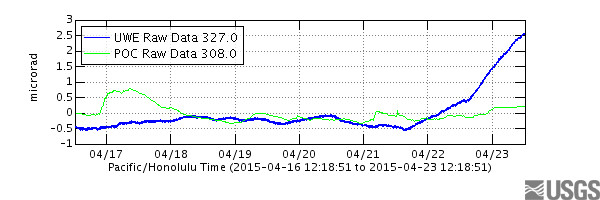HAWAII VOLCANOES NATIONAL PARK – The Kilauea volcano summit lava lake at Halema’uma’u has risen to its highest point since October 2012, and spatter from the lava was barely visible from Jaggar Museum this morning, according to the USGS Hawaiian Volcano Observatory.
The rising lava lake coincides with an increased rate of summit inflation, which began with a steady climb on Tuesday evening and a steeper increase on Wednesday. As of this posting on Thurday, the inflation continues.
Inflation at the new rate continues this morning. In concert with the inflation, the level of the summit lava lake rose to what may be its highest level since October 2012. It was measured at 28 m (90 ft) below the rim of the Overlook crater yesterday evening, and had climbed a few more meters (yards) by this morning. Spattering at the south edge of the lake was barely visible from Jaggar Museum this morning. The high level also triggered a few small collapses from the Overlook crater walls over the past day. Along with the activity described above, seismicity has increased beneath Kilauea’s summit and upper East Rift Zone. Sulfur dioxide emission rates averaged 4000-7000 tonnes/day for the week ending April 14.USGS Hawaiian Volcano Observatory on April 23, 2015 at 7:22 a.m.
Excitement over the current volcanic activity will likely increase as word gets out about the rising lava lake, as it did in October 2012. The summit is located within Hawaii Volcanoes National Park. This video is from that time, two and a half years ago.
The current summit eruption began in March 2008. This summary is posted on the USGS HVO website:
Summit The summit lava lake is within an elliptical crater (unofficially called the Overlook crater), which has dimensions of approximately 160 m (520 ft) by 210 m (690 ft), inset within the eastern portion of Halemaʻumaʻu Crater. The lake level has varied from about 25 m to more than 200 m (out of sight) below the floor of Halemaʻumaʻu Crater. The Overlook crater has been more-or-less continuously active since it opened during a small explosive event on March 19, 2008. The lake level responds to summit tilt changes with the lake generally receding during deflation and rising during inflation. Since 2013, the lava level has been typically between 30 m (100 ft) and 60 m (200 ft) below the floor of Halemaʻumaʻu Crater. Small collapses in the Overlook crater are common, and over time have resulted in a gradual enlargement of the Overlook crater. The ambient SO2 concentrations near the vent vary greatly, but are persistently higher than 10 ppm and frequently exceed 50 ppm (upper limit of detector) during moderate trade winds. The gas plume typically includes a small amount of ash-sized tephra (mostly fresh spatter bits and Pele’s hair from the circulating lava lake). The heaviest pieces are deposited onto nearby surfaces while the finer bits can be carried several kilometers before dropping out of the plume.


by Big Island Video News1:00 pm
on at
STORY SUMMARY
Spatter from the lava was barely visible from Jaggar Museum this morning, according to the USGS Hawaiian Volcano Observatory.